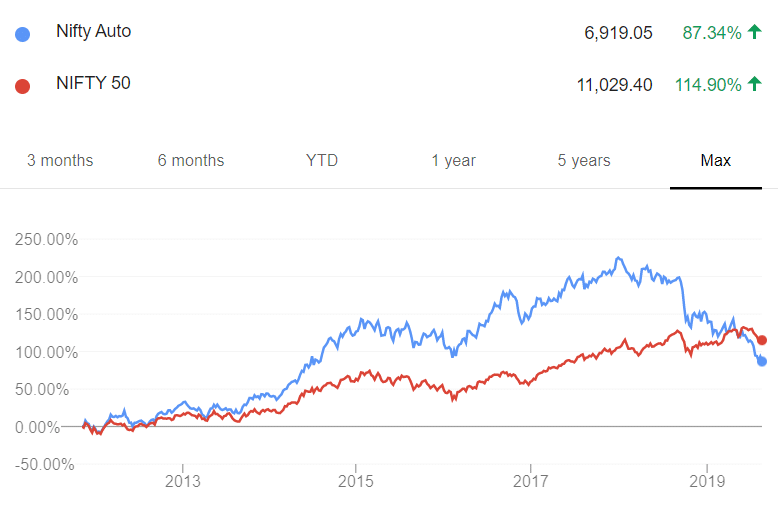Indian Auto Sector continues to go through a rough patch as passenger vehicle sales declined by 31% in July, this was the steepest decline since December 2000. Multiple OEMs (Original equipment manufacturer) including Tata Motors, Hero Motocorp and Mahindra & Mahindra have announced Shutdown plans for a few days. This if anything, should serve as a reminder of how hard it is to invest in sector funds.

The chart above tracks the performance of the Nifty Auto Index vs the Nifty 50 Index. Going back to 2011, from when the data is available, the return on Nifty Auto is below that of Nifty 50. If you chased returns in the auto sector and invested in 2016 / 17 after 3-5 years of good performance, you are probably down a significant amount in this sector.
As always we recommend not to invest in sector funds or funds that have high sector allocations. Sector timing is as hard, if not harder, than market timing. And more likely than not you will fall into the “behaviour gap” in sector investing – i.e buy the hype and eventually sell in the downturn.
Capital markets were gripped by concerns about a recession after the U.S. Treasury 10y – 3m yield curve temporarily inverted on Wednesday for the first time in 12 years. Let’s dig a bit deeper into what it means by yield curve inversion. It simply means that the longer-dated government securities (5y or 10y) are yielding lower than the shorter-dated government securities (3m and 2y). So the 10y – 3m yields are negative instead of being positive, as they usually are.
While there is no accepted theory on why a yield curve inversion leads to recession, it has so happened that the 5 times that the 10y – 2y US treasury yield curve has inverted it has led to a recession.
Some data you need to keep in mind when you read such news –
- 10y – 2y yield curve has still not inverted. And that’s the measure some investors use to look for a recession indicator.
- In the 5 prior instances, the S&P 500 Index peaked an average of 13.1 months after the inversion happened.
- The S&P 500 has made an all-time high 5 out of 5 times after the yield curve inverted.
- The average onset of the recession was over 20 months after the yield curve inverted.
The sample size at 5 historic observations is too low to make any meaningful statistical inference. Add to that the lack of any credible theory on why yield curve inversion leads to recessions, you should take all such news with a pinch of salt.
Our views stay rock solid – ensure that your goal-based asset allocation is right, and be the best at your day job. As Walt Disney once famously said –
I’ve heard there’s going to be a recession. I’ve decided not to participate.
: Walt Disney
Index Returns
| Index | 1W | 1Y | 3Y |
| NIFTY 50 | -0.6% | -3.0% | 8.5% |
| NIFTY NEXT 50 | -0.9% | -11.8% | 4.7% |
| S&P BSE SENSEX | -0.6% | -0.8% | 10.0% |
| S&P BSE SmallCap | -0.9% | -24.6% | 1.0% |
| S&P BSE MidCap | -1.3% | -16.5% | 1.7% |
| NASDAQ 100 | -0.6% | 3.1% | 16.6% |
| S&P 500 | -1.0% | 1.7% | 9.9% |
Source- BSE/NSE
Top 5 best performing funds
| Name | 1W | 1Y | 3Y |
| PGIM Global Equity.. | 2.6% | 14.1% | 12.0% |
| Canara Robeco Gold Saving | 2.1% | 25.2% | 5.3% |
| Edelweiss Greater China | 2.1% | 2.7% | 11.5% |
| Invesco India Gold | 2.1% | 22.6% | 4.8% |
| DSP Natural Resources & .. | 2.0% | -14.3% | 8.0% |
Source – Kuvera.in
Top 5 worst performing funds
| Name | 1W | 1Y | 3Y |
| Franklin Feeder Europe… | -2.8% | -12.6% | 0.5% |
| Kotak World Gold | -2.7% | 20.8% | -7.8% |
| DSP World Gold | -2.6% | 28.9% | -4.8% |
| Tata India Pharma & Health | -2.4% | -3.0% | -1.8% |
| UTI Healthcare | -2.3% | -13.2% | -5.2% |
Source – Kuvera.in
What investors bought
We saw the most inflows in these 5 Funds –
| Name | 1W | 1Y | 3Y |
| Mirae Emerging Bluechip | -0.4% | 1.4% | 13.7% |
| Parag Parikh Long Term Eq.. | -1.5% | -3.1% | 11.2% |
| Kotak Standard Multicap | -0.1% | -1.1% | 11.0% |
| UTI Nifty Index | -0.5% | -1.8% | 9.7% |
| Mirae Large Cap | -0.5% | 0.2% | 11.8% |
Source – Kuvera.in
What investors sold
We saw the most outflows in these 5 Funds –
| Name | 1W | 1Y | 3Y |
| Reliance Gold Saving | 0.5% | 25.0% | 4.9% |
| Indiabulls Saving Income | -0.2% | 5.5% | 9.9% |
| Kotak Infrastructure & Eco.. | -1.3% | -4.6% | 5.1% |
| Taurus Banking & Fin.. | -0.9% | 3.8% | 13.7% |
| IDFC Multi Cap | -0.7% | -9.1% | 5.4% |
Source – Kuvera.in
Movers & Shakers
1/ Aditya Birla Sun Life Mutual Fund has appointed Vinod Bhat as a fund manager and a Key Personnel of Aditya Birla Sun Life AMC Limited with effect from 16 August 2019.
2/ Reliance Mutual Fund has appointed Vikram Dhawan as Fund Manager – Commodities & Key Personnel of Reliance Nippon Life Asset Management Limited, with effect from 01 August 2019.
3/ Essel Mutual Fund has designated Kamlesh Dixit and Niraj Singh as key personnel of Essel AMC, with effect from 12 August 2019.
4/ BSE Star MF, which handles 20% of all Mutual Fund transactions, broke past its own record of most number of transactions in a day. The exchange processed 8.56 lakh transactions on Tuesday, valuing Rs 1,287 Crore. The previous best was 7.62 lakh transactions on June 10, 2019.
Quote of the week:
The function of economic forecasting is to make astrology look respectable.
: John Kenneth Galbraith

Feature Showcase: Tax Harvesting
Tax Harvesting is a technique that utilises the ₹1 Lakh annual LTCG exemption by selling and buying back part of your investment such that you “realise” gains and not pay taxes on them. At a 10% LTCG tax rate, you could save up to Rs 10,000 in LTCG taxes every year by doing this diligently.
Do not wait for February / March to harvest taxes. Do it as early in the financial year as possible – you may not have gains later to harvest!
Like all our features, Tax Harvesting optimizes on your entire portfolio – bought on Kuvera or imported from elsewhere.
Start harvesting today.
Start investing through a platform that brings goal planning and investing to your fingertips. Visit kuvera.in to discover Direct Plans and start investing today.
#MutualFundSahiHai, #KuveraSabseSahiHai!










